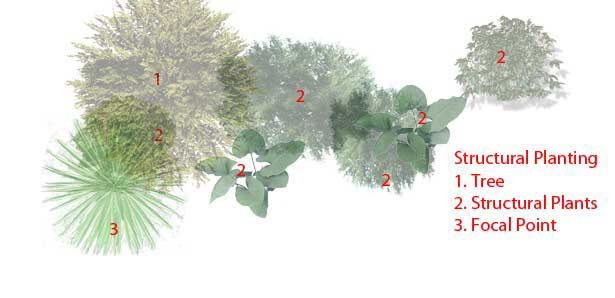Designing with plants in an ornamental garden
Many plants you may be familiar with in ornamental gardens appear in the Plants For A Future Database. It is a nice surprise that these familiar plants have many other uses that may have not been considered before and can certainly make you see your ornamental garden in a completely different light. Many of the plants in the top rated list for edibility and medicinal uses could be familiar to you already and have the added bonus of being great to eat or medicinally good for us.
When creating a planting plan it is important to consider the best use for each plant. There are a number of different ways of designing with ornamental plants. One way of viewing plants is by their design use under the following categories: Focal Points, Seasonal Interest, Structural Plants, Midrange Plants, and Ground Cover.
Front View

Plan View
Focal Points
A focal point is a visual treat in the garden. Focal points are used in garden design to lead the eye to a particular spot in the garden. When looking down the garden the eyes need something to help them ‘pause’ otherwise the whole garden will be taken in very quickly with a passing glance. They need a point to focus on; a focal point. A focal point must stand out from the other items in the garden. Once the eyes have rested on a focal point they will then explore the other garden plants and features around it. Larger gardens can have more than one focal point as long as they are not competing and you can also use secondary focal points that also draw the eye but do not compete with the main focal point. In a larger garden focal points can be used to direct people through the garden taking them on a journey to explore the full extent of the design. It is possible to have focal points appearing only in certain positions so they do not compete with each other. Focal points can include:
- water features
- an unusual plant specimen
- a group of plants
- a vibrant colour contrasting with other colours
- large architectural plants
- an ornament e.g statue or bird bath
As well as attracting attention towards a point in the garden focal points can also draw your attention away from unsightly objects or views.
Acer palmatum, Cornus alternifolia, Phormium and Yucca
Midrange
Midrange plants can include bulbs, herbaceous perennials, grasses and small shrubs. Plants can be chosen not just for their flower colour but also for their shape and texture. Plants with a strong leaf shape include: Ananthus, Bergenia, Crocosmias, Cynara, Hosta, Ligularia, Rogersia. Midrange plants will be the majority of plants in the ornamental garden once the structure has been established. These plants fill the gaps between the larger structural plants.
Ground cover
Ground cover are low-growing, dense plants not greater than 24 inches, that provide a continuous cover of the ground surface between other plants. Typically ground cover plants will spread outward, eventually covering all surrounding bare soil. They can be herbaceous plants (including grasses and ferns), small shrubs and non-vascular plants. They are used to exclude weeds and have their own decorative features in the ornamental garden.
Ajuga reptans, Bergenia cordifolia, Ceratostigma plumbaginoides, Helleborus niger, Geranium, Epimedium grandiflorum, Epimedium sagittatum, Hypericum calycinum, Cornus canadensis, Euonymus fortunei
Structural Planting
Structural plants act as the framework or ‘bones’ of the garden. They can include shrubs, small trees and plants with a strong form like Coryline or Gunnera. They provide broad shape creation and spatial definition. Hedges, for example, form the boundary of a garden or garden space. They can be used as a backdrop for plants, as a separator for different parts of a garden bed or garden (for example when creating ‘garden rooms’ where the garden is separated into distinctly different zones) and can frame a planting bay or hide an unsightly view. In addition structural planting can create shelter and privacy. When planting with perennials it is worth considering a strong structure of plants for when perennials die back in the winter so the garden continues to have some form and interest. Evergreen plants are ideal for this.
Seasonal Interest
The well-designed garden offers visual interest all year round, even in the heart of winter. After the bare branches of winter, spring bulbs bring a renewed sense of hope with the abundance of new life, summer flowering perennials offer a riot of color, and in the autumn we have the delight of the russets, golds, scarlets, crimsons and the purples of all those wonderful autumn foliaged plants. Succession planting helps to ensure there is something in bloom from spring through fall, but as the cooler weather arrives, seed heads and foliage color take center stage. During the winter months some perennials can continue to provide visual interest with their strong form, along with evergreen perennials and shrubs. One of the best features of ornamental grasses is that they remain standing through winter, standing as glorious golden beacons in the crisp white snow.
We tend to think of colour in the garden coming from flowers but not all colour in the garden needs to come from flowers or fruit. The leaves of plants can be used to enliven a garden design. Leaves can be used as eye catching focal points as well as complimenting the colour of a flower or fruit in season. Leaves can also be used to create contrasting combinations of colour and form.
Reference:
Garden Design 2009. Chris Young. DK Publishing. New York